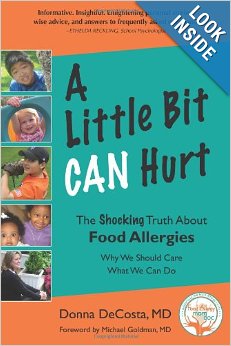The holiday season (and life in Southeast Louisiana) is all about food. Everyone has their favorite treats that they only get this time of year and everyone is ready to share. But, if your child is one of the estimated 15 million Americans who have food allergies, so many treats can be downright dangerous. The term “allergy” conjures images of sneezing and watering eyes but food allergies present much more severely, with exposures resulting in hives, swelling of the face and breathing passages, anyphalaxis and even death. Kind of a grim thing to think about at the most wonderful time of the year, but the fact of the matter is food allergies are on the rise and the family recipe for pralines could be deadly, especially for the youngest members of the family, as more and more children are being diagnosed with food allergies.
Of the estimated 15 million people with food allergies, roughly 1 in 13 children are affected. One of my twins, my daughter, is one of those children. After her first taste of peanut butter at 18 months old, she developed a bright red rash on her face, while her twin brother was fine. Testing by an allergist gave us a formal diagnosis and an EpiPen, and the instruction to “strictly avoid” peanuts, which means peanuts, and anything that could possibly contain peanuts, as well as tree nuts because the two are usually processed together. It’s been a process adjusting to our new normal as having a child with a potentially life threatening food allergy. Food was once divided into categories such as “things I like” and “things I don’t like” is now divided into categories of “safe” and “not safe”.

I was offered the opportunity to read and review an electronic copy of A Little Bit Can Hurt by Donna DeCosta, a physician and mom of two food allergic sons. The book is a great educational tool, divided into two sections: interviews with families of food allergic children and interviews with professionals. In the first section, there are interviews with families of children in all stages. It was so helpful to read and see that I’m not alone in managing food allergies (even if it feels like it sometimes) and learn from the stories, tips and tricks of other families.
But the book isn’t just meant for parents of those with food allergies. It’s also to meant helpeducate those in a “Food Allergy Circle”, that is, those people who are involved in the care or lives of a food allergic child. Given the rise in food allergies, if you are fortunate enough to not have a member of your family that suffers from them, it’s pretty likely that you will encounter someone who does, such as a classmate or friend of your child. Most of us didn’t know anyone with food allergies growing up, so it’s a totally new way of thinking to realize that even a small amount of an allergen can make a child sick; that yes, a little bit can hurt. But, such is the reality and Dr. DeCosta strives to educate everyone because at some point, everyone is likely to become a part of someone’s Food Allergy Circle.
The stories in Part I help the caregivers, friends and family of a food allergic child understand what parents do and what it takes to keep a child safe by preventing direct exposure to the allergen, and by preventing cross-contact (i.e. a knife dipped in jelly after being in a jar of peanut butter could cause a reaction in a peanut allergic).
Part II of the book interviews community members, which includes medical professionals, educators, a board member of FARE (Food Allergy Research & Education) and a chef who has created a program for food allergy management in commercial kitchens. These interviews provide information on research and development of treatments in food allergies, management and handling of food allergies in schools from the administration’s perspective, and eating out with food allergies. These chapters provide solid, real-life information on how people are helping those of us with allergies in our family staysafe while at school or restaurants, and hope that in the next few decades there will be a cure for food allergies.
As food allergies become more and more prevalent in society, education on all parts is the key to keeping those with allergies safe. As a parent, I am teaching my child to always ask what is in food and not to eat anything that I haven’t checked out; it’s our responsibility to make sure that a food is safe before it’s eaten. But, it’s always helpful when I encounter another parent or waiter who understands the potential gravity of the situation and why I am asking so many questions. If you have anyone in your life who has food allergies, A Little Bit Can Hurt is a great resource.
Aimee
Latest posts by Aimee (see all)
- How to Take Kids to Mardi Gras - February 14, 2023
- Halloween Activities on the Northshore - September 5, 2022
- Bayou Jam Concerts in Slidell - November 2, 2021
